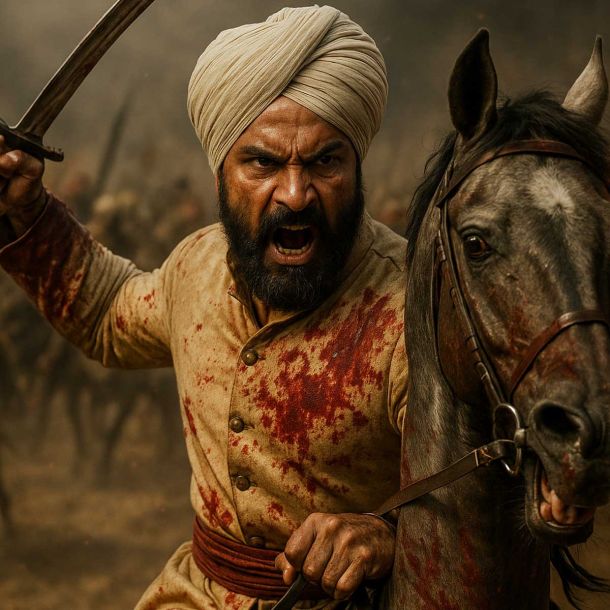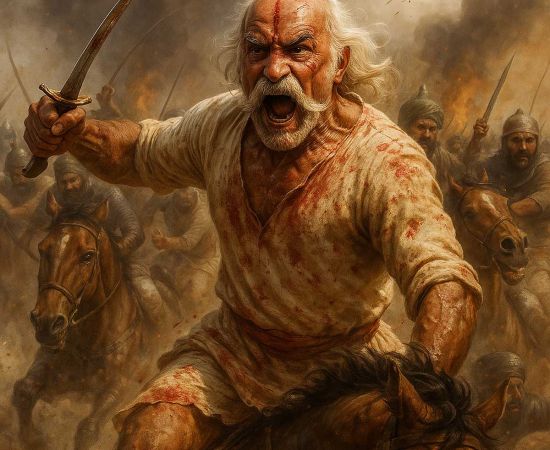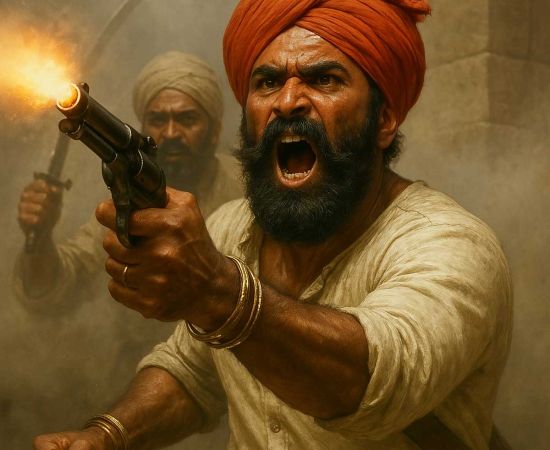MORE COVERAGE
Twitter Coverage
Satyaagrah
Written on
Satyaagrah
Written on
Satyaagrah
Written on
Satyaagrah
Written on
Satyaagrah
Written on
JOIN SATYAAGRAH SOCIAL MEDIA
History, tainted by biases, conceals the valor of Hemu—a Hindu king & military genius in medieval India, orchestrating 22 victories, he reshaped history at the Battle of Panipat, his strategic brilliance defied odds, leaving indelible mark on the warfare
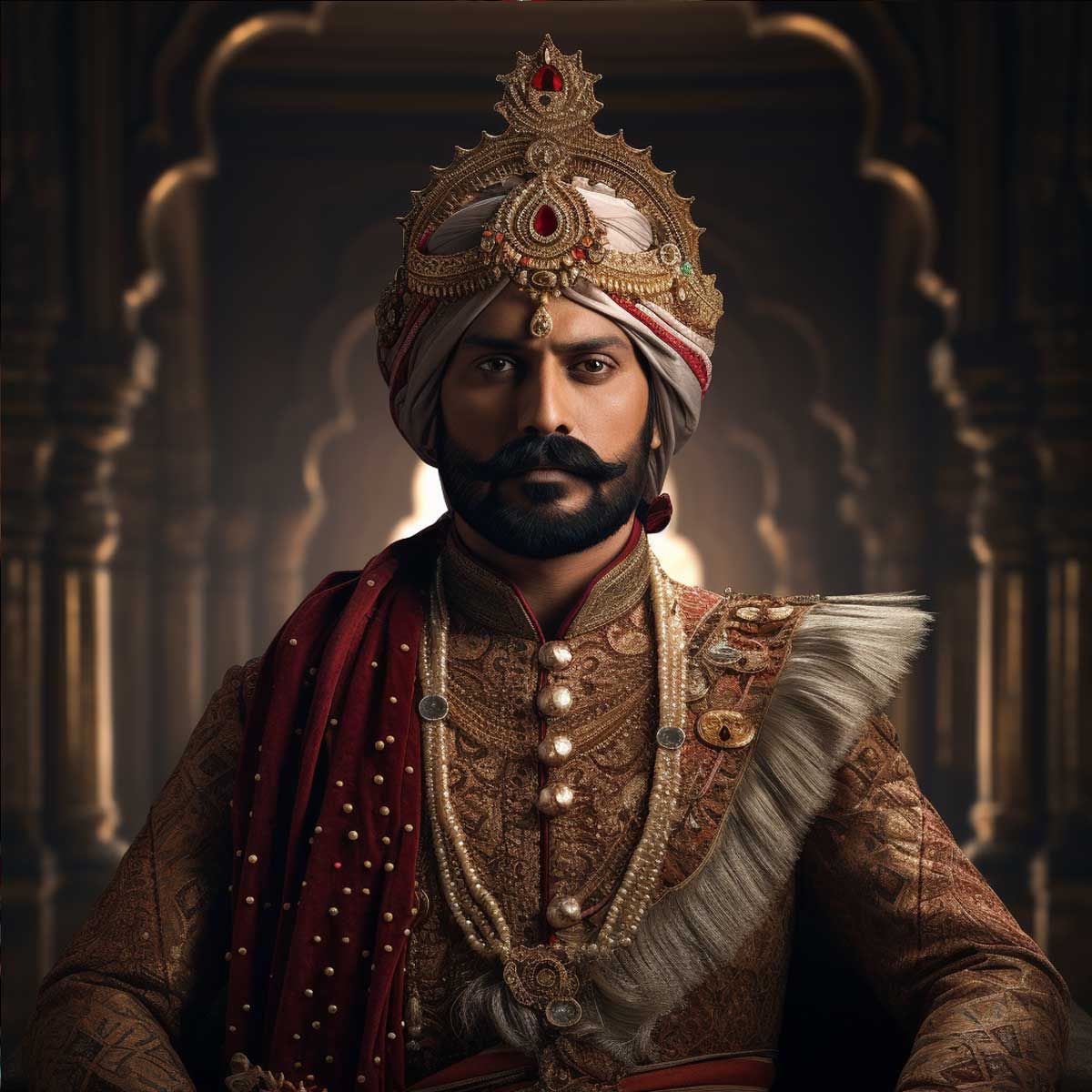
In the annals of history, the distortion of facts by historians to align with the interests of governments is a recurring theme. This tendency, prevalent in both ancient court historians serving monarchs and their modern counterparts in democratic settings, has led to a blurring of objectivity. It is within this historical maze that a remarkable figure, a Hindu King named Hemu (Hem Chandra Vikramaditya), has been unjustly overlooked, his significance brushed aside by biased historical accounts.
|
Hemu, the unsung hero, rose to prominence during the barbaric medieval times, winning an astonishing twenty-two battles. His rule extended over Delhi, and he played a pivotal role as the chief character in the Second Battle of Panipat. However, due to the biases ingrained in historical writings, his exclusive personality and the magnitude of his deeds have been obscured, leaving a significant gap in our understanding of India's past.
'Samrat Hem Chandra Vikramaditya,' as he is often referred to, emerged as the last Hindu emperor of India, defying societal expectations as a member of an ordinary family. His extraordinary contributions to Indian history were characterized by innovative ideas and visionary pursuits aimed at elevating Bharat into a powerful nation. Hemu dedicated himself to altering the destiny of India's future, leaving an indelible mark on the course of history.
Beyond his visionary ideals, Hemu showcased remarkable capabilities as an administrator, military genius, shrewd politician, and far-sighted statesman. In the true spirit of the great Hindu ruler Prithvi Raj Chauhan, Hemu fearlessly led his people in battles, mirroring the dedication and sacrifice witnessed in the annals of Indian history.
Hemu's legacy extends beyond the battlefield; he stands as one of the greatest freedom fighters in India's history. His relentless struggle against foreign rulers underscores his commitment to the cause of an independent India. In essence, Hemu emerges not just as a man of ideas and ideals, but also as a figure of prompt actions, brilliant, and courageous deeds, deserving recognition in the tapestry of India's collective memory.
|
From ancient times, Delhi has served as a pivotal center of political power, with its influence dating back to the legendary city of Indraprastha. According to Robert Eric Frykenberg, the control of Delhi has been a litmus test for rulers, symbolizing true dominance over Hindustan. It is in this historical context that Hemu, also known as Hem Chandra Vikramaditya, carved his name into the narrative of Delhi's political landscape.
On October 7, 1556, Hemu achieved a significant victory in a day-long battle at Tughlaqabad, a village situated five miles east of the iconic Qutb Minar. Instead of establishing the Islamic flag of the Suri Dynasty, Hemu took a momentous step by crowning himself the emperor of Delhi. Under the title of Vikramaditya, a term harkening back to India's ancient Vedic past, Hemu ushered in a rule by a Hindu King in Delhi after centuries, even if for a brief period.
The Persian texts, serving as the primary source of information about Hemu, also carry their share of biases. Authored by court historians of the Mughals such as Abdul Qadir Badayuni and Abul Fazl, who wrote for Akbar, an adversary of Hemu, these accounts may not present an entirely impartial view of the historical figure.
Scholars have varied opinions about Hemu's birthplace and caste, adding another layer of complexity to his historical identity. Ram Prasad Tripathi, in his work "Rise and Fall of the Mughal Empire," characterizes Hemu as a Dhusar, considered a sub-division of Gaur Brahmins. On the other hand, John F. Richards categorizes him as a Vaishya, while R. C Majumdar presents him as a Dhusar or a member of the "Dhansar section of the Baniya caste." Satish Chandra labels Hemu as "Dhusar or Bhargava, who claim to be Gaur Brahmins," and Kalika Ranjan Qanungo classifies him as a Dhusar, a "caste of the Vaish or Baniyas, who now claim to be Bharagava Brahmins." The diversity of perspectives further adds intrigue to the enigmatic persona of Hemu, inviting historians to unravel the layers of his identity and contributions to India's rich history.
Hemu's Humble Beginnings and Early Life
Hemu's origin, as depicted by Mughal historian Badayuni, traces back to the small town of Rewari in present-day Haryana, located in the taluk of Mewat. Badayuni suggests that Hemu, initially a green vendor, embarked on a journey that would lead him to the pages of history. Other accounts posit him as a hawker in the town of Mewat, engaging in various trades. Historian R.C Majumdar sheds light on Hemu's early years, indicating that he entered the workforce at a young age, either as a green-grocer or selling saltpetre.
Born in the village Machheri, just three miles away from Rajgarh in the Alwar region of Rajasthan, Hemu entered the world in the heart of a Dhusar Brahmin (Bhargava) family in 1501. His father, Puran Das, played dual roles as a Purohit and a deeply religious individual. Saint Puran Das later took Sanyas and migrated to Varindavan to live with the renowned saint Harivansh of the Vallabha Sampradai or sect.
Seeking better prospects, the family later relocated to Qutabpur, a village of Dhusar Brahmins in Rewari, Haryana. It was in this environment that Hemu spent his formative years, receiving upbringing and education. His curriculum included studies in Hindi, Sanskrit, Persian, and Arabic, showcasing a diverse educational background. In his childhood, Hemu developed a fondness for wrestling and horse-riding, displaying early signs of the physical prowess that would later define him.
Rewari, situated on the main trade route connecting traders from Iran and Iraq to Delhi, provided Hemu with opportunities to engage in commerce. He began by supplying cereals to Sher Shah's army, marking the initial steps of his involvement in the military supply chain. Subsequently, Hemu expanded his role to include the supply of saltpeter, a crucial component for gunpowder, further solidifying his position within the military infrastructure. These early experiences laid the foundation for Hemu's remarkable journey from a small-town vendor to a significant player in the historical events of his time.
Hemu's Rise in the Political Landscape
Following Shershah Suri's demise on May 22, 1545 A.D., Jalal Khan, the younger son, ascended to power with the title of Islam Shah. Recognizing Hemu's exceptional capabilities and administrative prowess, Islam Shah appointed him as a personal advisor. This role extended beyond matters of trade and commerce to encompass statesmanship, diplomacy, and general politics. Hemu's competence led to his elevation to the position of Shang-ah-i-bazar, or the 'Shuhna' superintendent of the market in Delhi, accompanied by a foundation of soldierly experience.
In 1550 AD, Hemu's influence expanded as he accompanied Islam Shah to Punjab. Their mission involved receiving Mirza Kamran, the second son of Babar, in the fort of Rohtas. Hemu's significance as a consultant to Islam Shah grew, extending to all matters of paramount importance. During this period, Islam Shah ruled over the vast expanse of North India, spanning from Punjab to Bengal.
Hemu's meteoric rise continued as he was promoted to the crucial position of the Chief of Intelligence, known as Daroga-ai-dak-chauki, or the Superintendent of Posts. In the years 1552 and 1553, he further solidified his influence by holding prestigious positions as the Governor of Punjab and Delhi state. These appointments underscored Hemu's strategic importance in the administration, reflecting the trust and reliance placed in him by the ruling powers of the time. As Hemu's responsibilities expanded, so did his impact on the political landscape, setting the stage for the events that would unfold in the chapters of India's history.
In November 1554 A.C., the political landscape shifted once again as Islam Shah passed away, leaving his 12-year-old son, Firoz Khan, as the ruler. However, within three days, Firoz Khan met a tragic end at the hands of Adil Shah Suri, also known as Mubrez Khan or Mubarak Khan. Adil Shah, the new ruler, proved to be an indolent, pleasure-seeking, and debauched leader, facing revolts on multiple fronts. In this tumultuous period, Adil Shah turned to Hemu, recognizing his competence and leadership. Hemu, now the Chief Advisor, practically took charge of all affairs, assuming the roles of Prime Minister and Chief of the Afghan Army.
The esteemed historian A.L. Srivastava highlights Hemu's significance, stating, "As he (Hemu) proved his worth and loyalty, he was promoted to the post of Prime-Minister and thus earned the distinction of being the first of the two Hindus, the other being Todar Mal, who occupied the position of the Chief Minister of any Mohammadan ruled state during the medieval period of our country’s history" (The Mughal Empire, 1952, P.128).
Hemu's rise to power was propelled by his remarkable abilities in both war and civil administration, setting him apart in the Suri Dynasty. His unwavering honesty, devotion to the state's interests, and strict stance against corrupt public servants earned him both admiration and adversaries. Amidst a degenerated official nobility, Hemu emerged as a highly efficient civil administrator and the best military genius after Sher Shah from the Afghan side. His cool demeanor, fearlessness, and confident decision-making skills further solidified his position as a key figure in the tumultuous political landscape of the time.
|
Hemu: The Victorious Military Strategist
In the face of widespread revolt among Afghan governors against Adil Shah, Hemu took charge, traveling across North India to quell these uprisings. His leadership in this tumultuous period was marked by an impressive military campaign, engaging in a total of 22 battles, all of which he emerged victorious from.
Abul Fazl and Badauni, the chroniclers of these battles and victories, present accounts colored by their personal biases against Hemu. Historian Dr. Rajinder Singh Kushwaha notes, "Since both of them hated Hemu, they painted him in the black colour. Their restrained praise is all the more valuable as a testimony to the valour and military skill of Hemu."
Abul Fazl's records highlight the battles between Hemu and Ibrahim, a claimant for the sultanate, where Hemu consistently emerged victorious. Even Sultan Mohammad, who had assumed the kingly title in Bengal, faced defeat at the hands of Hemu, being forced to tread the land of annihilation. Hemu's military prowess extended to conflicts with Taj Karrani and Ruku Khan Nuhar, both of whom he defeated. Engaging in a total of twenty battles against the opponents of Mubrez Khan, Hemu showcased unwavering strength and emerged victorious in every encounter. These triumphs solidified his reputation as a formidable military strategist, navigating the complex political landscape of his time with skill and determination.
As Humayun endeavored to reclaim his lost throne in India, Adil Shah strategically deployed Hemu northwards to oppose him, while Adil Shah himself retreated to Chunar. Tragedy struck for Humayun on January 26, 1556 AD, as he met a fatal accident. In the aftermath, Hemu, recognizing the opportunity to prevent Akbar from effectively seizing his father's kingdom, remained in the field.
Hemu took decisive action, consolidating his army and advancing from Gwalior to Agra. In Agra, he encountered and defeated Iskandar Khan Uzbeg, the Governor of Agra. The victory granted Hemu control over Agra, its substantial treasure, and military equipment. With momentum on his side, Hemu proceeded towards Delhi, marking a pivotal moment in the unfolding events.
In response to the threat posed by Hemu, Tardi Beg Khan, the Mughal Governor of Delhi, alarmed by the impending danger, urgently dispatched a message to Akbar and Bairam Khan, seeking reinforcements for the defense of the capital. In a swift response, Bairam Khan deployed his most capable commander, Pir Mohammad Sherwani, along with a formidable army. The stage was set for a significant confrontation in Delhi, with the battle unfolding at Tughlaqabad.
In this clash of forces, Hemu emerged victorious, defeating the Mughals and further consolidating his influence over the region. This triumph positioned Hemu as a formidable force, challenging the Mughal dominance and altering the course of history in the unfolding drama of 16th-century India.
|
The Historic Battle of Tughlaqabad
In the heart of modern-day Delhi, the area around Qutab Minar and Tughlaqabad witnessed a momentous battle on October 7, 1556. This clash pitted Hemu, widely known as Hem Chandra Vikramaditya, against the forces of the Mughal emperor Akbar, commanded by Tardi Beg Khan. Prior to this engagement, Hemu had already asserted his dominance, driving the Mughals out of key territories like Bayana, Etawah, Sambhal, Kalpi, Narnaul, and Agra. Such was Hemu's influence that the Mughal Governor of Agra evacuated the city and fled to Delhi in fear.
According to Akbar's Court Historian Badayuni, Hemu approached Delhi with a formidable force, comprising 50,000 sawars, 1,000 elephants, 51 pieces of cannon, and 500 falconets. The stage was set in Delhi, specifically Tughlaqabad, where the Mughals, led by Tardi Beg Khan, Iskandar Beg, and Haidar Muhammad, prepared to face the challenge posed by Hemu.
Despite having numbers on their side, the Mughals found themselves struggling to resist Hemu's formidable challenge. Faced with the imminent threat of death, many Mughal officers fled in terror, abandoning any defense. Tardi Beg Khan, the chief commander of the Mughals, eventually took the same course. This decisive encounter on October 7, 1556, resulted in Hemu capturing Delhi.
Rather than establishing the Islamic flag of the Suri Dynasty, Hemu took a momentous step by crowning himself the emperor of Delhi, assuming the title of Vikramaditya. This title, echoing the ancient Vedic past of India, marked the rule of a Hindu King in Delhi after centuries, even if for a brief period. According to Badayuni, Hemu's actions were perceived as an attempt to destabilize the ordinances of Islam, while some scholars differ on whether Hemu proclaimed himself as an independent king. The Battle of Tughlaqabad not only altered the political dynamics of the time but also contributed to shaping the narrative of India's diverse and complex history.
|
Following his triumph in Delhi, Hemu asserted his independent status and initiated a coronation, Rajyabhishek, at Purana Qila. The ceremony, attended by Afghan and Rajput commanders, unfolded with elaborate religious rituals. Hemu took the historic name 'Vikramaditya' or Raja Bikramjit, underlining his regal authority. To solidify his rule, he reorganized the army, made strategic appointments without removing Afghans, and implemented significant reforms in the mercantile system. Hemu's commitment to ethical governance was evident as he dismissed corrupt officers and replaced them. Additionally, he prioritized cow protection, imposing a total prohibition on cow slaughter.
However, Hemu's reign faced a decisive challenge just a month later in the form of the Second Battle of Panipat, fought on November 5, 1556. This critical engagement witnessed the forces of Hemu clashing with the army of Akbar, led by his generals Khan Zaman I and Bairam Khan. The battle concluded in a decisive victory for Akbar's forces. During the war, Hemu was wounded by a chance arrow and captured unconscious on the battlefield.
In a grim turn of events, Akbar's regent, Bairam Khan, beheaded the almost lifeless Hemu shortly after his capture. In homage to Hemu's memory, his supporters erected a memorial at the spot in Panipat where he was beheaded, now known as Hemu's Samadhi Sthal. This chapter marked the end of Hemu's brief but impactful rule and the ascension of Akbar's dynasty, shaping the course of Indian history in the 16th century.
While Hem Chandra Vikramaditya's rule lasted a mere 29 days, its historical significance resonates profoundly in the annals of India. He accomplished a remarkable feat by re-establishing a Hindu Kingdom after centuries of foreign dominance. Renowned historian R.C. Majumdar aptly described it as "a unique episode in the history of India during the Muslim rule."
Historian A.L. Srivastava addresses the bias that has colored the perception of Hemu, stating, "Modern European writers have joined the medieval chronicles (whose prejudice to a Hindu, who made any attempt to free his country from foreign yoke is obvious) in finding fault with him." Despite such biases, Srivastava emphasizes that an impartial student of history cannot overlook Hemu's qualities of leadership and the swiftness with which he seized the opportunity to remove alien rule from the capital. Hemu's actions were not unreasonable or immoral; instead, they were driven by the legitimate aspiration to rule over his ancestral land, a claim as valid as any put forth by foreign rulers.
R.C. Majumdar concurs, stating, "there is nothing unreasonable or immoral in the aspirations of Hemu... it may not be altogether wrong to think that he was inspired by the ideas of founding a Hindu Raj." In the context of the political landscape of his time, Hemu's brief yet impactful reign represented a bold assertion of indigenous rule and a temporary shift in the tides of history. Hemu's legacy endures as a testament to his determination, leadership, and the enduring quest for self-rule in the complex tapestry of India's history.
|
With the news of Delhi falling from Akbar's control, the Mughal army at Kalanaur faced a crisis of morale. Many commanders, disheartened by the situation, refused to engage in a battle against Hemu. They urged Akbar to retreat to Kabul for safety. However, Bairam Khan, showing determination, refused to back down and insisted on facing Hemu in battle.
The decisive clash between Hemu and the Mughal forces unfolded at Panipat on November 5, 1556 AD. Historian V.A. Smith provides an account of the battle, stating, "The armies met in battle on November 5, 1556. At first, Hemu was successful on both wings. Probably he would have been the victor but for the accident that he was hit in the eye by an arrow and rendered unconscious. His army, when deprived of its leader, the sole reason for its existence, dispersed at once" (The Oxford History of India (1923) P.344).
In a tragic turn of events, Hemu was captured in an unconscious and almost dead state. Bairam Khan, eager for Akbar to earn the title of Ghazi, requested him to wield his sword on the captive. Akbar fulfilled the request and struck Hemu on the neck. Subsequently, Hemu's head was sent to Kabul to confirm to the Afghans that he was dead, while his trunk was displayed at one of the gates of Delhi, marking the culmination of a pivotal chapter in Indian history. The Battle of Panipat not only decided the fate of Hemu but also played a crucial role in shaping the trajectory of Mughal rule in India.
The tragic tale of Hemu and his family did not conclude with the Battle of Panipat. Following Akbar's triumph, Mughal forces extended their dominion to the Sarkar of Alwar, the very home of Hemu. Mughal officers advanced towards the township where Hemu's family resided, initiating a series of events that would further compound the tragedy.
Abu Fazl, offering a somber account, describes the unfolding events, stating, "The palace was strong and there was much fighting, and the father (Puran Das) of Hemu was captured and brought alive before the Nazim-al-mulk." The intensity of the struggle is evident as the forces sought to subdue the stronghold where Hemu's family had sought refuge.
In a poignant exchange, the Nazim-al-mulk, the Mughal officer in charge, called upon Hemu's captured father to convert to Islam. The old man, Puran Das, responded with steadfast conviction, saying, "For eighty years I have worshipped my God, according to this religion. Why should I change it at this time, and why should I merely for fear of my life and without understanding it come into your way of worship." Despite the plea, Pir Mohammad, treating the words as if unheard, responded in a tragic manner—answering with the "tongue of the sword."
This grim episode reflects the harsh realities faced by Hemu's family in the aftermath of the battle, portraying the complex interplay of power, religion, and personal conviction during a tumultuous period in Indian history.
The Mughal vengeance did not cease with the capture of Hemu; it extended to the entire clan of Dhusar Bhargavas, Hemu's family. They were relentlessly hunted throughout the region, facing brutality as they were beheaded. To showcase the extent of this brutality, pyramids made from their skulls were constructed, a macabre display of the ruthless reprisals enacted by the Mughals. The vivid depiction of such atrocities during Akbar's time is preserved in the National Archives in New Delhi, with a replica exhibited at the War Museum in Panipat. Astonishingly, these grim pyramids persisted even 60 years later during Jahangir's rule, as noted by Petre Mundy, a British traveler, in his travelogue on India during that period.
Historian R.C. Majumdar poignantly reflects on the tragic fate of Hemu's family, stating, "such was the noble end of the family of Hemu, a great Hindu who was born as humble life but made his way to the throne of Delhi." This somber reflection encapsulates the profound tragedy that befell the once-prominent family, extinguishing the remnants of an era that briefly challenged centuries of foreign domination.
The demise of Hemu marks the end of a glorious yet fleeting chapter in Indian history. In praising Hemu's bold endeavor to re-establish indigenous rule at Delhi after more than 350 years of foreign domination, we acknowledge the resilience and audacity of a figure who, despite the brevity of his reign, left an indelible mark on the complex tapestry of India's historical narrative.
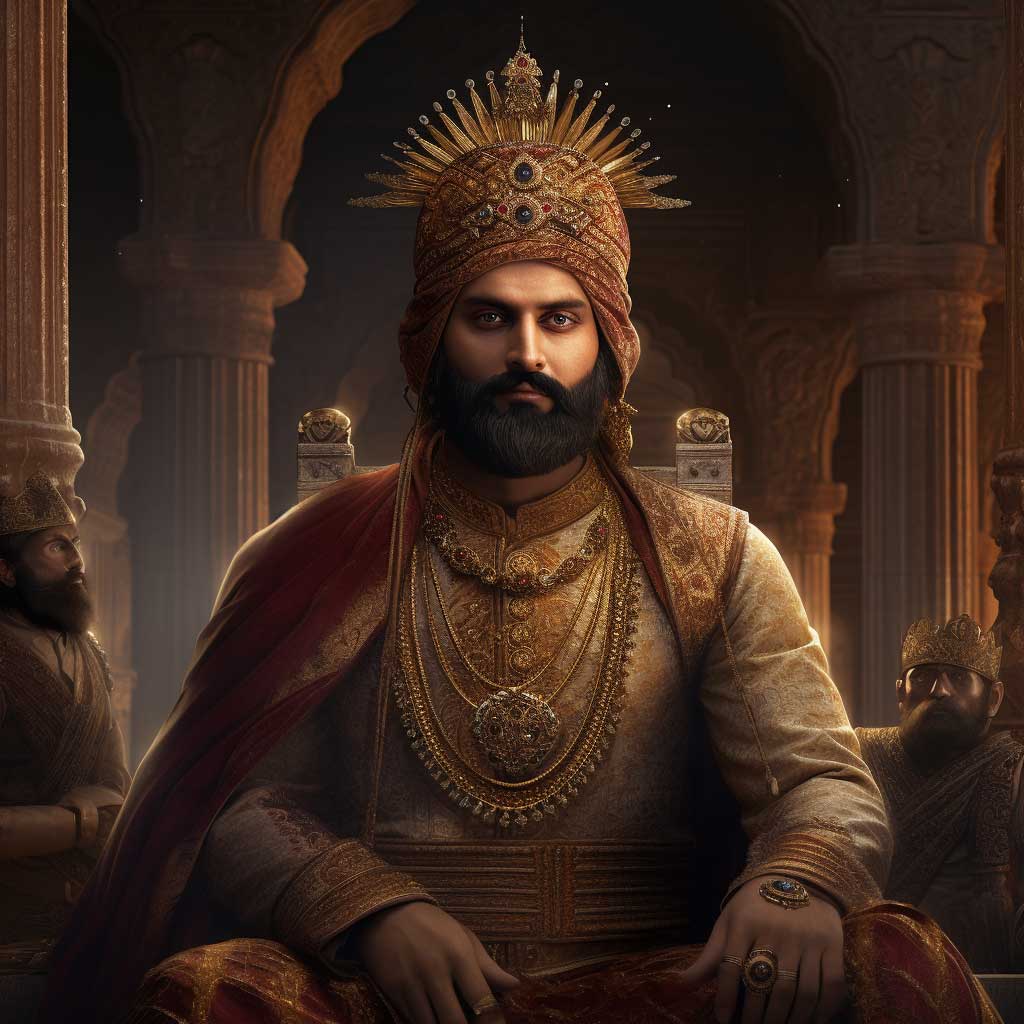 |
 Support Us
Support Us
Satyagraha was born from the heart of our land, with an undying aim to unveil the true essence of Bharat. It seeks to illuminate the hidden tales of our valiant freedom fighters and the rich chronicles that haven't yet sung their complete melody in the mainstream.
While platforms like NDTV and 'The Wire' effortlessly garner funds under the banner of safeguarding democracy, we at Satyagraha walk a different path. Our strength and resonance come from you. In this journey to weave a stronger Bharat, every little contribution amplifies our voice. Let's come together, contribute as you can, and champion the true spirit of our nation.
 |  |  |
| ICICI Bank of Satyaagrah | Razorpay Bank of Satyaagrah | PayPal Bank of Satyaagrah - For International Payments |
If all above doesn't work, then try the LINK below:
Please share the article on other platforms
DISCLAIMER: The author is solely responsible for the views expressed in this article. The author carries the responsibility for citing and/or licensing of images utilized within the text. The website also frequently uses non-commercial images for representational purposes only in line with the article. We are not responsible for the authenticity of such images. If some images have a copyright issue, we request the person/entity to contact us at satyaagrahindia@gmail.com and we will take the necessary actions to resolve the issue.
Related Articles
- Operation Polo: When India annexed Hyderabad from the Nizam and Razakars, the suppression of Hindus and the role of Nehru
- "The relentless pressures of the so-called marketplace have distorted all our history and culture": 'Revolutionaries - The Other Story of How India Won Its Freedom'' by Shri Sanjeev Sanyal says History of India’s freedom struggle must be re-written
- Harmonizing Nathuram Godse: Why India should move beyond denouncing him, a man who altered the course of not only the politics of the country but the very history of the Hindu Civilisation and, by extension, the world at large
- Unsung Heroine Pritilata Waddedar, Who Shook The British Raj at the age of 21
- Letter to Shaheed Sukhdev 5th April, 1929 - Collected work of Shaheed Bhagat Singh and his Co-patriots
- "जय भवानी": Chhaava crosses ₹200 crore, tearing through the distortion of history, unveiling Aurangzeb’s brutality, triggering a tear-jerking meltdown of the Islamo-leftist cabal, and marking a civilizational awakening as Bharat reclaims its truth
- Reality of Britishers who tortured, brutalized Indian women and threw them into sexual slavery
- "And he saw the angel in the marble and carved until he set him free": Granite monolithic Nandi of 16 feet in height and 24 feet long sits atop the Chamundi Hills of Mysore, creation of this colossal image is attributed to Maharaja Dodda Devaraja Wodeyar
- When Nehru ignored warnings from Sardar Patel and Sri Aurobindo and shocked USA President: Chinese Betryal and loss of centuries old ally
- Kartar Singh Sarabha - The Freedom fighter who was Hanged at the age of 19 and inspired Bhagat Singh
- "Copyright? Copy RIGHT: Steal ideas, steal facts but do not steal words": Did you know the Greek version of Trojan Horse at Troy from Odyssey was an adaptation of the original Indian version of the Trojan White Elephant from Brihatkatha, a Sanskrit play
- Why Hindu-Sikh genocide of Mirpur in 1947 ignored? Why inhuman crimes of Radical Islamists always hidden in India?
- How Communism murdered Freedom of Expression: 100 Years of Russian Revolution
- "GururBrahma GururVishnu GururDevo Maheshwaraha": Rejuvenating the eminence of Nalanda University, the pride of Bharat that was the world’s leading education center for decades, long before Cambridge and Oxford were even architectural designs on a map
- Valiant Marathas and the far-reaching effects of the loss of 3rd battle of Panipat: Jihad of the temple destruction
